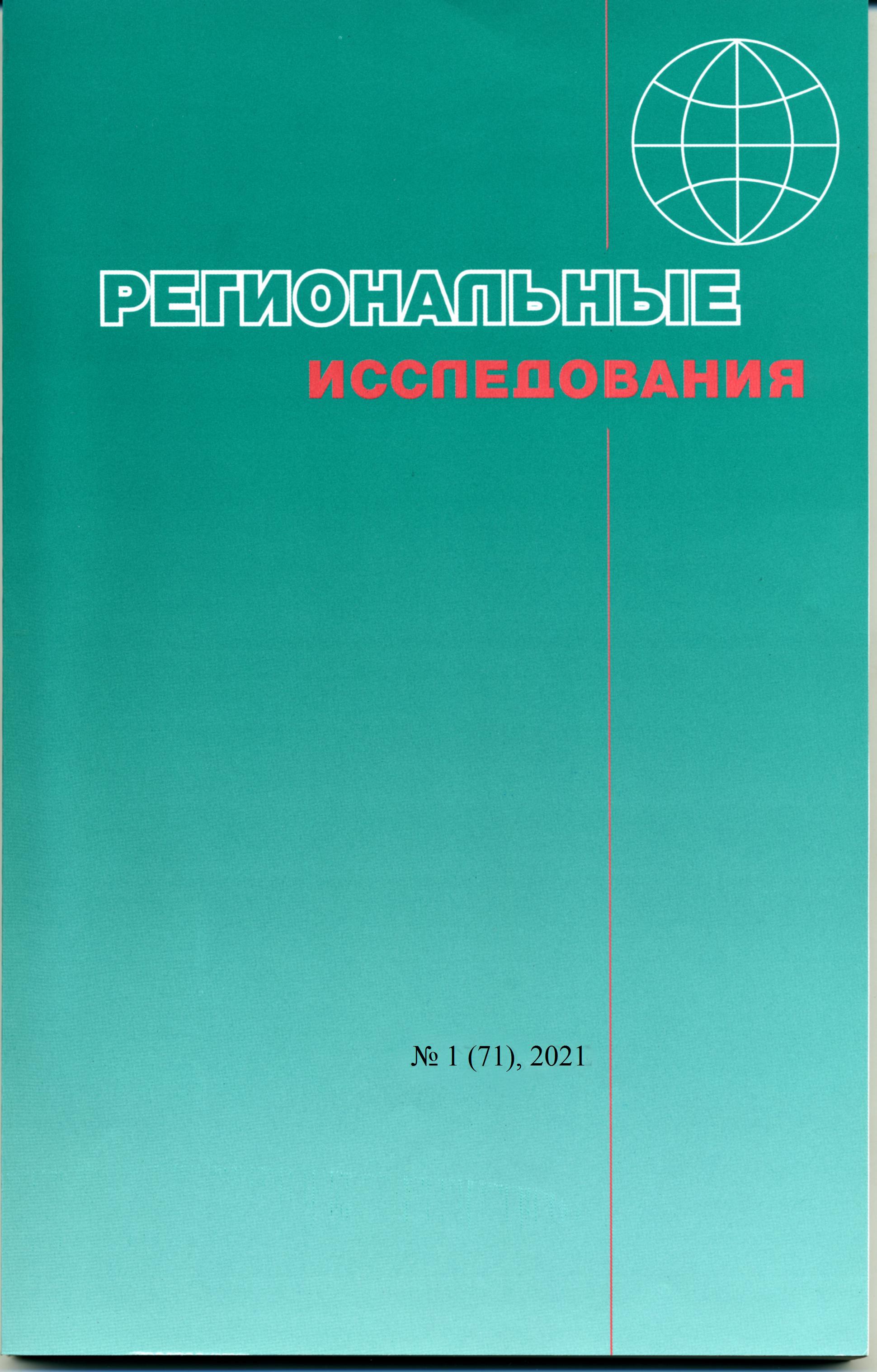Baklanov P.Ya., Ushakov E.A. General and intra-district trends and priority areas of socio-economic development of Sakhalin Oblast
DOI:
https://doi.org/10.5922/1994-5280-2021-1-6Keywords:
Sakhalin Oblast, socio-economic characteristics, territorial differentiation, development factors, priority areas, diversification of the economyAbstract
The article describes the features of the socio-economic situation of Sakhalin Oblast, its development trends since the 1990s, both general and territorially differentiated ones. The economic and geographical position of the region with allocation of conditional market zones, including foreign destinations, is considered. Data on the state and dynamics of the main socio-economic indicators of the region, as well as its place in the Far Eastern Federal District by these indicators are provided. The dynamics of the population of the region is shown. The oil and gas industry and gas processing make a basis of the modern economy of the region that stipulates high values of the socio-economic indicators. Favorable and unfavorable factors that can affect the long-term development of the region are highlighted. The comparison of Sakhalin Oblast with other constituent entities of the Russian Federation is carried out using the proposed integral coefficient of the ratio of socio-economic indicators. The levels of the development in all municipal districts were assessed by 7 different socio-economic indicators. The large territorial differences in nearly all individual socio-economic indicators were revealed. Based on the scoring of all socio-economic indicators, the districts were grouped according to their general level of the development. These assessments also showed significant intra-district socio- economic differentiation. Taking into account a number of available favorable prerequisites, the regional development program and scientific proposals for diversification of the economic development of the region, the priority economic activities were summarized; and the role of the territories of advanced development (TADs) being created in the region was shown. Some conclusions were made about the role of the prerequisites in location of priority activities in many areas of the region.
Financing
The results of the study were obtained as part of a government assignment Ministry of Education and Science of the Russian Federation (topic "Geographical and geopolitical factors in inertia, the dynamics and development of different ranked terterritorial structures of the economy and of the population of Pacific Russia, " No. AAAA-A16-116110810013-5. Section 1). Sta-prepared with financial support RFBR grant, project No. 18-05-80006.
References
Анисимова Е.А. Управление инновационным социально-экономическим развитием природноресурсного региона: на материалах Сахалинской области: дисс. … канд. экон. наук. Южно-Сахалинск, 2013. 215 с.
Архипов Г.И. Минеральные ресурсы горнорудной промышленности Дальнего Востока: обзор состояния и возможности развития. М.: Горная книга, 2011. 830 с.
Афанасьев В.В. Проблемы берегопользования Сахалинской области // Проблемы региональной экологии. 2010. № 2. С. 142–148.
Бабурин В.Л. Социально-экономическая эффективность развития транспортно-коммуникационной инфраструктуры Сибири и Дальнего Востока // Общественно-географическая структура и динамика современного Евразийского пространства: вызовы и возможности для России и ее регионов. Мат-лы Междунар. науч. конф. Владивосток: ТИГ ДВО РАН, 2020. С. 12–19.
Бакланов П.Я., Романов М.Т. Направления долгосрочного развития Дальневосточного региона России // Вестник ДВО РАН. 2019. № 4. С. 6–18. DOI: 10.25808/08697698.2019.206.4.001
Бакланов П.Я., Романов М.Т. Факторы и приоритеты долгосрочного развития территориальных структур хозяйства Тихоокеанской России // Таможенная политика на Дальнем Востоке России. 2011. № 4. С. 27–46.
Быстрицкий С.П., Заусаев В.К., Хорошавин А.В. Дальний Восток России: становление новой экономики. Хабаровск: Изд-во ДВГАС, 2008. 346 с.
Дальний Восток – шаг вперед: информационное издание / Волков П., Боярко Д., Сачков Е. и др. Владивосток: ДВО РАН. 2018. 111 с.
Жданкина А.Ю. Промышленный профиль региональной экономики Сахалинской области: оценка состояния и динамика развития // Вестн. Моск. гуманит.-экон. ин-та. 2010. № 1. С. 47–53.
Живага А.Ю. Южно-Сахалинск от города к агломерации // Экономика: вчера, сегодня, завтра. 2019. № 7-1. С. 59–69.
Земцов С.П., Бабурин В.Л. Оценка потенциала экономико-географического положения регионов России // Экономика региона. 2016. № 1. С. 117–138. DOI: 10.17059/2016-1-9
Зубаревич Н.В. Социальная дифференциация регионов и городов // ProetContra. 2012. № 4-5. С. 135–162.
Карачурина Л.Б., Мкртчян Н.В. Роль миграции в усилении контрастов расселения на муниципальном уровне // Изв. РАН. Сер.геогр. 2016 № 5. С. 46–59. DOI: 10.15356/0373-2444-2016-5-46-59.
Кручак Н.А. Методические подходы к оценке эффективности сценариев развития Сахалинской области // Власть и управление на Востоке России. 2014. № 1. С. 44–50.
Мошков А.В. Структурные сдвиги в промышленном производстве Тихоокеанских регионов России // Ученые записки Забайк. гос. ун-та. 2015. № 1. С. 98–106.
Мошков А.В. Факторы устойчивого развития территориально-отраслевой структуры регионов прибрежной зоны Тихоокеанской России // Регионалистика. 2019. № 4. С. 14–31. DOI: 10.14530/ reg.2019.4.14
Об утверждении стратегии социально-экономического развития Сахалинской области до 2035 года. Постановление Правительства Сахалинской области от 24 декабря 2019 г. № 618. 494 с.
Регионы России: Социально-экономические показатели. 2019. Стат. сб. / Росстат. М., 2019. 1204 с.
Синтез научно-технических и экономических прогнозов: Тихоокеанская Россия 2050 / под ред. П.А. Минакира, В.И. Сергеенко. Владивосток: Дальнаука, 2012. 912 с.
Стратегический экономический обзор. Стат. справочник. № 15–39. Владивосток: Тихоокеанская инвест. группа, 2019.
Тимашков И.И. Формирование нефтегазового комплекса в Дальневосточном федеральном округе России: основные направления, проблемы и перспективы: автореф. дисс. … канд. экон. наук. М., 2007. 26 с.
Ушаков Е.А. Оценка факторов неравенства субъектов по совокупности социально-экономических показателей // Успехи современного естествознания. 2020. № 1. С. 61–69. DOI: 10.17513/ use.37322.
Хорошавин А.В., Заусаев В.К. Сахалин в XXI веке: новый вектор развития. Хабаровск: Хабар.краевая типогр., 2012. 432 с.
Филобокова Л.Ю., Жданкина А.Ю. Научно-методическое обеспечение управления промышленным комплексом территории опережающего социально-экономического развития (на примере Сахалинской области). М.: Перо, 2020. 170 с.
Филобокова Л.Ю., Лемдяева Л.А. Подходы к социально-экономическому развитию природноресурсного, приграничного региона (на материалах Сахалинской области) // Региональная экономика: теория и практика. 2010. № 15. С. 2–10.
Шанькин Д.А. Основные элементы социально-экономического состояния и перспективы устойчивого экономического развития Сахалинской области // Журнал правов. и экон. исследований. 2017. № 31. С. 220–225.

